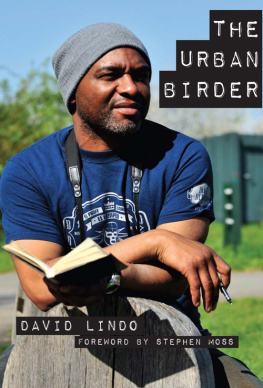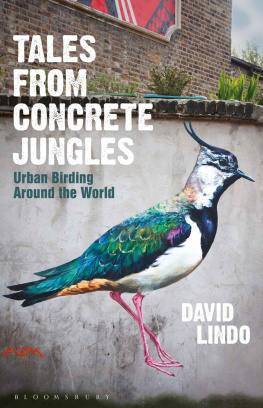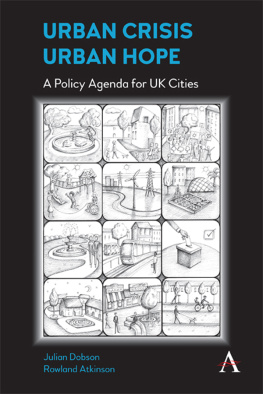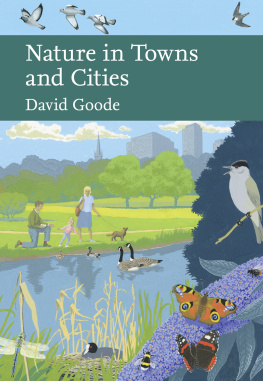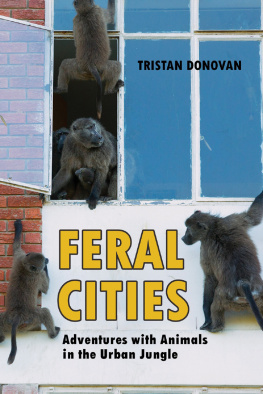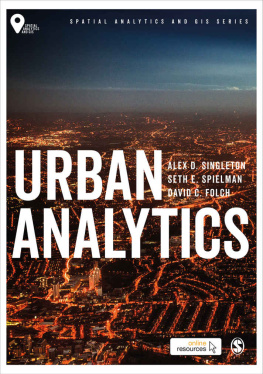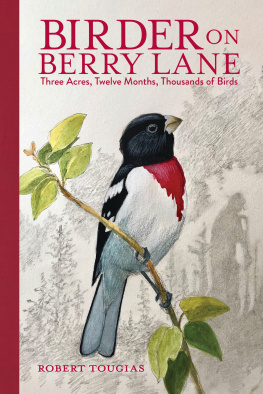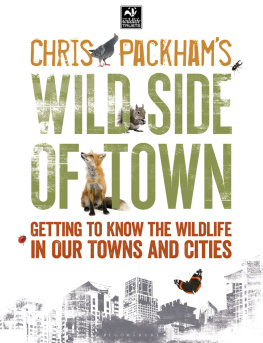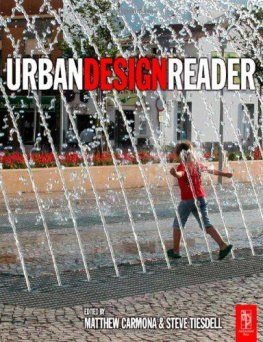THE
URBAN
BIRDER
THE
URBAN
BIRDER
DAVID LINDO
This e-book published in 2011
Printed edition first published in 2011 by New Holland Publishers
London Cape Town Sydney Auckland
www.newhollandpublishers.com
Garfield House, 86-88 Edgware Road, London W2 2EA, United Kingdom
80 McKenzie Street, Cape Town, 8001, South Africa
Unit 1, 66 Gibbes Street, Chatswood, NSW 2067, Australia
218 Lake Road, Northcote, Auckland, New Zealand
Copyright 2011 in text: David Lindo
Copyright 2011 in photographs: as credited below
Copyright 2011 New Holland Publishers (UK) Ltd
David Lindo has asserted his moral right to be identified as the author of this work.
All rights reserved. No part of this publication may be reproduced, stored in a retrieval system or transmitted, in any form or by any means, electronic, mechanical, photocopying, recording or otherwise, without the prior written permission of the publishers and the copyright holders.
A CIP catalogue record for this book is available from the British Library.
ISBN 978 1 84773 950 6 (Print)
ISBN 978 1 78009 149 5 (ePub)
ISBN 978 1 78009 150 1 (Pdf)
Publisher: Simon Papps
Editor: Stephen Moss
Production: Melanie Dowland
Photographs by Steve Daly ().
CONTENTS
FOREWORD BY STEPHEN MOSS
Urban Birding? Youve got to be kidding! Cities arent called the urban jungle for nothing, are they?! Surely they are a no-fly zone for birds?
Of course, as David Lindo points out in the following pages, nothing could be further from the truth. Britains cities and indeed cities all over the world are at least as good for birds as the surrounding countryside, and sometimes even better. Which when you think about it is just as well, because four out of five Britons, and over half the rest of the worlds seven billion inhabitants, live in urban areas and we all need to get close to nature.
Look closer and its easy to see why our cities are so good for watching birds and other wildlife. After all, they are packed with green spaces: parks, gardens and areas of woodland or scrub which are ideal for breeding and migrating birds. Almost all of Britains cities are built close to water: either on a river (the Thames, Tyne and Mersey, to name but three), or by the sea; and the same applies to many cities elsewhere around the globe. Water is always a magnet for birds whether for wildfowl that winter in huge numbers on city lakes and reservoirs, or for landbirds that simply need a place to drink and bathe.
Cities provide warmth and shelter: thanks to the urban heat-island effect, they are usually a few degrees warmer than the surrounding countryside, and less likely to freeze up in winter. And theres plenty of food, either occurring naturally, or provided by us accidentally or deliberately.
Which brings me to gardens: that amazing network of mini-habitats that form a patchwork-quilt across our towns and cities. Suburban gardens are, square metre for square metre, more biodiverse than any other habitat in the world, including the Amazon rainforest. Theyre also a brilliant place to watch birds whether you are a beginner or an expert, theres always something new to see. So when you look at whats on offer, it gives a whole new meaning to the phrase urban jungle.
If youre going to take a walk in the jungle, you need a guide and who better than The Urban Birder himself, David Lindo? As David reveals in the final chapter of this book, he and I go back almost two decades to a sunny spring day in Londons Richmond Park, where we both successfully twitched an Ortolan Bunting. Since then I have got to know him both as a colleague and a dear friend. Weve watched Red Kites soaring over the Metro Centre in Gateshead, some of the capitals last remaining House Sparrows at London Zoo, and on a memorable morning last autumn, absolutely nothing at all flying over Tower 42 in the heart of the City. Well, you cant hit the jackpot every time, can you?
And now David has set down these memories, stories and encounters with urban birds in Britain and around the world in this book. Because David and I were both brought up in suburban London, a few years apart, we share experiences of many of the people, places and birds about which he writes so eloquently. But five years ago I left London to live in Somerset, and so now I am The Rural Birder. At least when David comes to visit I can show him the wonders of the English countryside, before he succumbs to the urge to get back home to the Big Smoke.
If youre already a birder, whether urban, suburban or rural, theres plenty to delight you here tales of encounters with migrants and rarities, epic twitches and memorable days in the field going back almost four decades.
If youre not a birder or not yet please dont be put off. For this book should be read by anyone who has ever lived in, travelled through, or visited a city. It contains a vital message: that if we dont notice the wild creatures on our own doorstep, how are we going to look after those farther afield?
For me, the most memorable and moving parts of the book are Davids recollections of his early years, being brought up as a second generation black Briton, whose parents had come here from Jamaica in search of a better life. Through Davids eyes, ordinary events from a suburban childhood, stories about his Mum and Dad, and schoolboy memories, all combine to create a perceptive portrait sometimes sad, often very funny, but always fascinating.
You only have to be with David for five minutes to realise that he is one of lifes optimists, and a man of great openness, honesty and integrity. He believes passionately in many things, but above all in the power of birds and especially the birds we encounter in our cities to enhance, improve and occasionally transform our lives.
Too many of us spend our time staring at the ground. David goes through life staring at the sky, and the infinite promise it may bring; today, tomorrow or in the distant future. He is, quite simply, unique and so to borrow one of his many analogies to the world of popular culture:
To David Lindo, The Urban Birder May the Force be with you.
STEPHEN MOSS
Mark, Somerset, 2011
DEDICATIONS
For the men that made a difference.
Collin Flapper, Eric Simms, Peter J Grant, Rupert Hastings and my late father Edgar J Lindo.
ACKNOWLEDGMENTS
Thanks to all the people who have influenced me in their own particular way: Anna Guthrie and The Wildlife Trusts, Barry Hecker, Ceri Levy, Christiano Sossi, Ciska Faulkner, Clare Evans, Clare Lockhart, Dawn Balmer, Deborah Shaw, Delyth Lloyd, Derek Moore, Des McKenzie, Dolly Frankel, Dominic Couzens, Friends of The Scrubs, Gardman, Gary Elton, Hardeep Giani, Helen Babbs, Helen Marsh, Helga Berry, Jamie Oliver, Jay Pond Jones, Jen Hewlett and the Tower 42 Management Team, Jez Blackburn, Joan Scheckel, Kevin Barter, Leela Miller, Liliana dalla Piana, Lucinda Axelsson, Malka Holmes, Natalya Nair, Nick Baker, Peter Alfrey, Richard Chambers, Rick Simpson, RSPB, Sacha Barbato, Sally Cryer, Steve Barron, Stuart Winter, Susie Painter, Swarovski Optik, Tessa Dunlop, Tessa Winship, Tim Hunnable and Nikon, Tim Webb at RSPB London, Vicky Webb, WWT and to everyone else I havent named.
Special thanks to: Ring Ouzels, Dr Simon Papps, Jo Carlton, Alicia Cieplowska, Tasha Hall, Heidi Birkett, Alan McMahon, Roy Nuttall, Kim Dixon, Stephen Moss, John Charman, Anders Price, Bob Still, Yvette Spencer, Russell Spencer, David Fettes, David Foster, Doug Carnegie, Esther and Bert Higgs, Fiona Barclay, Max Whitby and all at BirdGuides, Jackie Michaelsen, Chris Palmer, Jo Thomas, Kirstine Davidson, Kevin Wilmott, Sheena Harvey and all at

